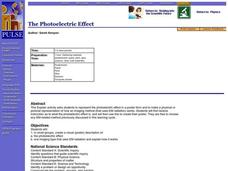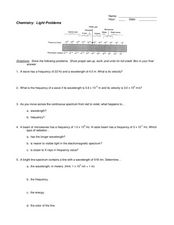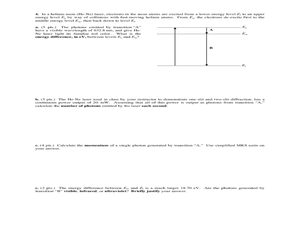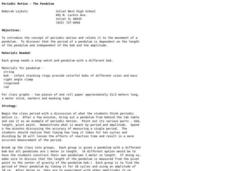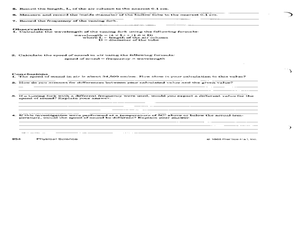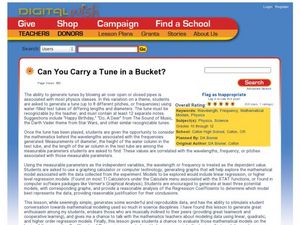Curated OER
The Photoelectric Effect
After some online instruction, chemistry aces use their creative abilities to produce a poster describing the photoelectric effect and one type of imaging technology that uses electromagnetic radiation. This simple, straightforward...
Curated OER
The Electromagnetic Radiation (Light ~ the Supreme Informant!)
This short slide show applies the electromagnetic spectrum to astronomy. First, electromagnetic radiation is introduced to viewers. Wavelength is defined and its unit of measurement explained. Finally, aspiring astronomers find that the...
Curated OER
Light Problems
In this light worksheet, students describe the electromagnetic spectrum based on wavelength and frequency. Students determine the wavelength, frequency, and energy for given point on the spectrum. This worksheet has 10 problems to solve.
Curated OER
The Photoelectric Effect
A single-page worksheet describes the photoelectric effect of metals exposed to light. The kinetic energy equation is given, and physicists learn how to use it for problem solving. Compact in content, this can be used as a homework...
Curated OER
Gallery Walk Questions on Earth's Radiation Balance
Questions that can be used in a lesson on Earth's radiation balance are suggested in this resource. It is not a lesson plan, per se, but it is a list of questions for stations within a "Gallery Walk" lesson. The link to how Gallery Walks...
Curated OER
What Wavelength Was That?
A combination of informative text, photos, and graphics comprise this sharp show on electromagnetic radiation. Some slides mention hands-on activities for demonstrating concepts, so if you want to include them you will need to figure out...
Curated OER
Catch a Wave. . .
Part of a larger online space science website, this page has a brief explanation of electromagnetic radiation and a chart of wavelengths as compared to common objects. There are four questions to answer about the information. This can be...
Curated OER
Now You See Me, Now You Don't
Bioluminescence fascinates most upper elementary scientists. Display images of different glowing deep-sea organisms and discuss their environment. Young biologists then experiment with images and different colors of filtered light. In...
Curated OER
Checking the Surf
Pupils read and discuss waves and their wavelengths and amplitudes. In this waves lesson plan, students draw the wavelength and amplitude of a wave and discuss tsunamis and storms.
Curated OER
The Sun's Energy
Sixth graders examine how the sun's energy arrives as light with a range of wavelengths. They discuss the characteristics of light, examine the color of light using a spectroscope, and conduct an experiment using water and thermometers....
US Department of Energy
Sunlight and Evaporation
Here is a simple inquiry experiment designed to demonstrate that the energy from sunlight can evaporate water. Young scientists follow provided procedural steps to construct a model of our atmosphere using a bowl, a cup, water and...
Curated OER
Physics Final Exam
A two-hour final exam covers a range of physics topics related to electricity and magnetism. It employs a variety of methodologies for assessing your physics learners' understanding and mastery of these concepts. You will need to review...
Curated OER
Measuring the Wavelengths of Visible Light
Students demonstrate use of an Emission tube power supply, a diffraction grating, and a scientific calculator to determine the different wavelengths of light.
Curated OER
Interactive Online Light Activity
Students participate in an online interactive activity in which they discover types of light, wavelengths of light, and how astronomers use different wavelengths. Activity includes links for other activities and lab activities including...
Curated OER
Wave Properties
Use this slideshow to explain waves. Energy travelling in waves and its behavior in different materials are explained. The diagrams and equations will assist your students in defining wave type and explaining the differences...
Curated OER
Sound Waves
Using a karaoke machine, a guitar, and other devices, learners explore the way sound waves travel. Using this hands on approach, learners can get a better understanding of wavelength, frequency, and more.
Curated OER
Super Gelatin
Students measure angles of refraction as the light travels through gelatin. For this experimental lesson students complete a refraction lab and plot their data.
Curated OER
Periodic Motion - The Pendulum
Young scholars experiment to determine the period of a pendulum. In this periodic motion lesson, students use different pendulums to determine their periods. They use various amplitudes to determine its effects on the period.
Curated OER
Speed of Sound in Air
In this speed of sound worksheet, high schoolers determine how fast sound travels in air using a tuning fork of known frequency, a graduated cylinder and hollow glass tubing. Students record their data and calculate the wavelength...
Curated OER
Can You Carry a Tune in a Bucket?
Students use water filled pipes to play a tune and consider the mathematics behind the sound waves. In this sound wave activity, students play a tune with water filled pipes. They create a mathematical model to evaluate the wavelengths...
Curated OER
F(x)g(x): A Tale of Two Functions
In this graphing functions worksheet, students solve four problems where they graph given functions, find the sum related to the area under the curve and determine an integral.
Curated OER
Slinky Movement Lab
In this wave instructional activity, students use Slinky's to observe the properties of waves. They observe longitudinal waves, transverse waves, traveling waves and standing waves and record their observations. They calculate the...
Curated OER
Sounds Good to Me
Learners determine density and hardness of wood samples based on several investigations. In this physical science and music lesson, students visit four centers and perform tests on wood samples to determine densities and hardnesses. They...
Curated OER
Woody Sine
Students explore the concept of sine. In this sine lesson, students create a sine graph from tooth picks. Students create a unit circle with tooth pick length radius. Students then take the tooth picks from the unit circle and put them...
